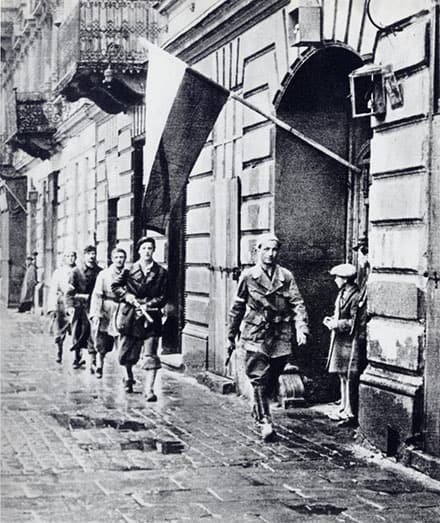

May and the May devotions (‘majowe’) – a Polish phenomenon
Anyone will be traveling through Poland in May should take the back roads: There is a good chance that in the evenings you will see groups of people gathering at wayside crosses, statues and chapels with pictures of the Virgin Mary, in the open air, against the backdrop of nature in bloom, for the May devotions, known as ’majowe’ or ’majówka’ for short. This is an old Polish tradition that is still alive today.
Attention is drawn not only to the people praying – usually women in festive dress – but also to the decoration of the shrines and statues. Long ribbons, usually blue and white – the colours dedicated to Mary – flow from the top of the shrine to the ground, giving the impression of a protective mantle or canopy. They mark the boundary between the sacred space and the rest of the world. The base of the shrine is decorated with wreaths of green branches and natural and artificial flowers. A unique 'garden’ is also being created around this sacred place. In addition to plants, it is filled with objects related to religious practices, such as bottles of holy water.
The greatest feast of colors, lights and shapes is the statue of the Virgin Mary herself. Illuminated by battery lights, it is surrounded by images of people for whom the local community prays and images of saints. The type and number of decorations and additional elements depend on the imagination of the shrine’s caretakers. Some prefer spontaneous abundance, others asceticism, and instead of many different decorations, they choose a few that are subordinated to a certain concept. It could be related to the life of the Virgin Mary or the patron saint of the parish or the nearest church. It then becomes a pictorial story on a given theme.

The decoration of statues and shrines, whatever their color or form, always expresses the praise of Mary as the Mother of the Son of God and protector of humanity, including the particular community. Above all, the prayers bear witness to this relationship. These include the Litany of Loretto and Marian hymns. They are particularly numerous in Poland because of the vitality of the cult of the Virgin Mary. Almost one hundred and fifty years ago, in 1876, Father Jan Siedlecki, a Varsovian who had been attached to the diocese of Krakow for decades, began to collect them. His hymnbook, supplemented by successive generations of editors, is still popular today, also in translations into other languages.

A chapel in Warsaw’s Praga district. Photo by Aleksander Keplicz : Forum 0782237836
The Marian song from Father Siedlecki’s songbook, which directly links the Virgin Mary with the beautiful month of May, is a hymn written by the Jesuit Father Karol Antoniewicz under the title 'Chwalcie łąki umajone’ (Praise the meadows of the meadowlands). He wrote it in the 1840s. He was a man of great spiritual strength. He came from an Armenian family. Before entering the Order he studied law in Lviv. He took part in the November Uprising. He married and had five children. Unfortunately, they all died young. His distraught parents then chose the path of religious life, and Father Karol found particular comfort in writing poetry. He published a collection of songs, 'Wianeczek majowy’ (Mayflower garland). It contained a joyful and solemn piece about man’s relationship with the eternally reborn nature and gratitude to Mary for the miracle of life expressed by humans and all of nature.
Connected to the fate of the people
It is said that King Alfonso X of Spain, who lived in the Middle Ages, was the first to dedicate May to the Virgin Mary, encouraging his subjects to gather and pray at her statues during the month. Catholics from Germany, France and Italy brought the custom to their countries. In the 18th century, the form of the May devotions, with mostly hymns, was created by Father Ansolani. At first, they were celebrated in the Royal Chapel in Naples. They arrived in Poland about a century later. Their promoters in the first half of the 19th century were the Jesuits of Tarnopol, from the Archdiocese of Lvov. They were followed by missionaries from the Church of the Holy Cross in Warsaw, Father Zygmunt Golian in Krakow and Bishop Jan Michał Marszewski of Włocławek.
A central pillar of these devotions, the ‘Litany of Loreto’, approved by Pope Sixtus V in 1587, is still a living text today. Successive Popes have added other invocations to the Virgin Mary, reflecting the destiny of the world and the history of nations. This was the case in 1917 when, during the First World War, a line was added to the litany: „Queen of Peace, pray for us”, in 1923, a few years after Poland regained its independence: 'Queen of the Polish Crown, pray for us’ (later changed to 'Queen of Poland…’). In recent years, several new invocations have been created to reflect the current global concerns and perplexities of millions of people. Mary has been called the Mother of Mercy, the Mother of Hope or the Consolation of Migrants.
May devotions in Poland were and still are not confined to the countryside; they have also become a tradition in the cities, including Warsaw, where the Second World War and the Warsaw Uprising gave special significance to devotions at Marian shrines. Hidden in the courtyards of tenement houses, they brought the capital’s inhabitants together in prayer for the salvation of Poland. The fallen were temporarily buried near them.
Tadeusz Seweryn (1894-1975), an ethnographer and folk art researcher, called the shrines dedicated to the Virgin Mary 'pearls’ scattered across Poland’s rural and urban landscape. In May they are beautifully flowered, i.e. decorated and permeated with prayers, testifying to the continuity of history, tradition and faith.
Karolina Prewęcka
Source:dlapolonii.pl




